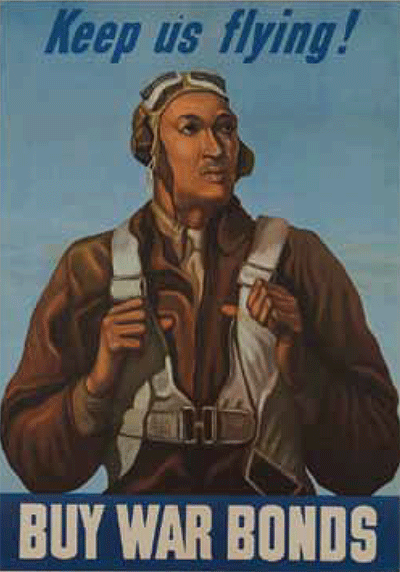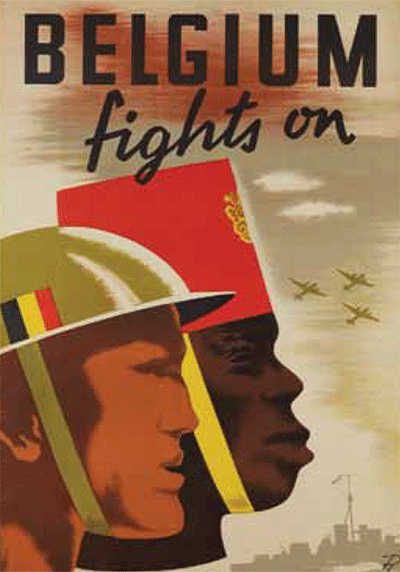Military posters are designed to be highly visible in public spaces. They become iconic images for those who remember wars as well as objects for generations of collectors and history enthusiasts. Black Bodies in Propaganda: The Art of the War Poster, a current exhibition at the Penn Museum, examines how images—primarily of African and African-American men—were used to mobilize Africans and African Americans in times of war.
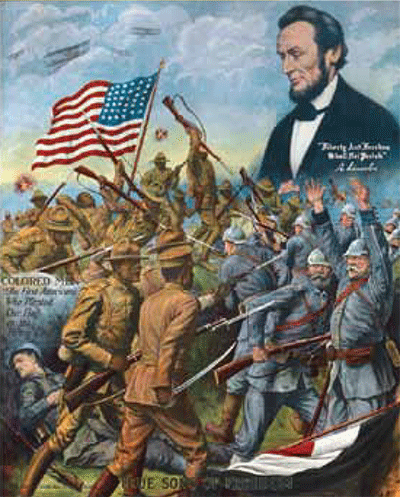
Our exhibition presents a unique group of posters, all from my personal collection assembled over many years. Each poster was produced either to encourage Africans and African Americans to support societies in which they were second-class citizens or to vilify the humanity of the black soldier. The posters in the exhibition are complemented by archival footage, a related episode of Public Broadcasting’s History Detectives, and a few artifacts from the Penn Museum’s African collection.
Using non-citizens as soldiers is an old practice, having its roots in ancient Turkey, Egypt, and the Roman Empire. The paradox of inviting African and African American soldiers to fight for governments under which they were subjugated did not correspond with the ideas of democracy. Democracy made it difficult, in fact, hypocritical, for the great nations of Europe and the United States to both deny full citizenship and invite the subjugated peoples to fight in preserving the Nation.
Our story begins with Civil War images of African Americans participating or being recruited to participate in a military effort that would redefine citizenship and democracy. During the Civil War, President Abraham Lincoln dispatched Louis Kurz to develop artistic representations of the principle battles of the war. This effort resulted in 36 lithographic posters of battle scenes and some of the first public images of the battlefields issued after the end of the war. Several of these posters, representing battles in which African Americans fought, are included in the exhibition.
In the 1800s, Europeans controlled over 35% of the Earth’s landmasses; between 1878 and 1914, during the period of “new imperialism,” this jumped to over 85%. The principle site of this expansion was Africa. The exhibition covers this period of new imperialism by providing a number of posters glorifying the European victories in the wars of colonial domination as well as posters used to recruit Africans to join the colonial military effort. Like Jim Crow in the United States, colonialism in Africa rendered blackness as synonymous with second-class citizenship. This second-class status was not typically shown in a positive light. Hence, the propagandistic nature of the posters denied the social practices that created the second-class citizenship, both in the United States and Africa.
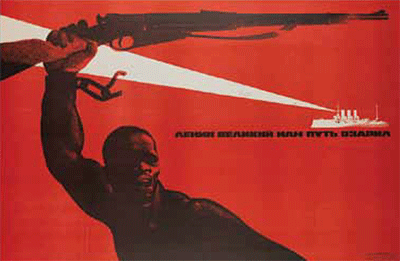
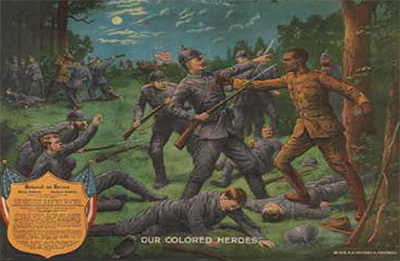
World War I was known as the “war to end all wars.” However, many people in the United States were opposed to getting involved in what they viewed as Europe’s war. In fact, Woodrow Wilson was re-elected on the basis of his promise to keep the United States out of the war. As war became inevitable, posters were used to help turn around public opinion. The government, once again, utilized the talents of artists to develop this pictorial publicity, to transform and mobilize America.
Both colonialism and the practices of Jim Crow provided justification for the social practices that prevented the spread of social, political, and economic equality throughout Africa and the African diaspora, including the United States of America. So it is not surprising that some of the American posters during World War I take advantage of Abraham Lincoln as a pivotal figure and often exhort the recruits or potential recruits to act under the moral guidance of Lincoln. Likewise, World War I era African posters included in this exhibition entice the African to become part of the military effort while exoticizing African customs, African community, and African desires.

The Civil War in the United States was fought about the abolition of slavery, providing an opportunity to redefine democracy and the meaning of citizenship. During World War I, the idea of preserving democratic interaction among the modern states was paramount. And World War II not only raised the issues of democracy and citizenship, but also challenged the entire world to redefine its notions of race. At the conclusion of World War II, there were many who called for the elimination of every vestige of racial injustice. So strong was this movement, that in 1948, Eleanor Roosevelt found herself proclaiming the Universal Declaration of Human Rights before the United Nations. Consistent with these changes in international thought, the Independence Movement was born in Asia and Africa. The Chinese and Russian posters included in our exhibition supported African Independence and the Civil Rights movement in the United States, calling for an end to racial tyranny.
By the close of World War II, the war poster had become a principle form of activism and engagement in the world. These military posters represented a visual dialogue of cultures, addressing the social status of Africans and African Americans. Some of these posters serve as a confirmation of the humanity of the black bodies depicted therein. This social fact is further confirmed when we look at the film and poster images which represented the black body as a savage, as in the case of A Birth of a Nation and the Italian Fascist poster “The 2 Dollar Venus.” The overtly racist depictions of the African body during the Civil War and World War II were efforts to maintain the racial status quo. From this perspective, recruitment posters as well as those created for the glorification of black participation in war were clear challenges to prevailing views. The racial practices in Africa and the United States were based on denying citizenship to those very people who were depicted on the posters as saving the world.
